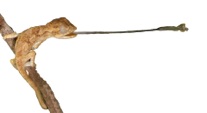Chameleon Care &
Information Center (CCIC)
Chameleon Care &
Information Center (CCIC)



Chameleons are generally insectivorous animals. Some are known to eat some plant matter like Ficus, bougainvillea, etc., but the majority of the concentration on their diet should be on insects. Being prone to hunger strikes and needing a well balanced diet, it is recommended that an assortment of feeders be kept on hand to offer as food and that each is well fed. An excellent cricket gutload recipe is available on Adcham.com, James/Wells/Lopez Gutload. When considering purchasing a gutload, please understand the information in the following article and ask questions of the supplier: Gutload Basics. Well fed feeders minimize the need for artificial vitamin supplementation. Calcium supplements are needed however. The frequency of vitamin and calcium supplementation varies by species, life stage, growth rates and reproductive rates.
In addition to crickets, other potential feeders include mealworms, superworms, waxworms, stick insects, roaches, fruit flies, house flies, mantids, silkworms, farm raised hornworms (wild hornworms feed on toxic plants), butterworms, cultured snails (wild snails have high parasite loads), field plankton, grasshoppers, anoles, pinkies and young finches. The best staple diets are crickets, roaches, silkworms and grasshoppers and field plankton collected in areas free of pesticide use. Mealworms should be fed sparingly as they are very high in chitin. Waxworms should only be used as treats as they not very nutritious as a staple. House flies are best when they have been cultured as they can carry a number of pathogens. Some chameleons like Jackson's are known to go after snails but other species tend to ignore them. Large species like C. parsonii, T. melleri and F. oustaleti have been known to take larger prey items like small birds, anoles and pinky mice. It is highly debated whether or not this is a good source of food for them but some speculate is a good calcium boost.
For more nutritional information and insect profiles, see the “Nutrition” and “Food Items” sections on The Chameleons! Online E-Zine Article Reference.
Many chameleon keepers rather cup feed their animals than free range feeders in their enclosures. This should only be done in cups with opaque sides to prevent the chameleon from injuring its tongue trying to shoot through the sides of the cup. Some animals don’t respond well to cup feeding. One way to increase their interest is to create a feeder that gives the illusion of free ranging crickets like shown in this article: Quick Feeders.
Captive Feeding
Copyright © 1998-2014 Christopher V. Anderson. All Rights Reserved.
Reproduction in whole or part is expressly forbidden without written permission.
For permission, please contact Christopher V. Anderson at cvanders@mail.usf.edu